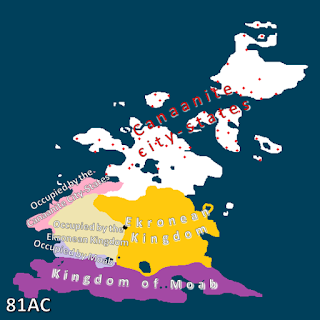GELOAN HISTORY | WAR AGE (89AC to 449AC) | DARK AGE (450AC to --AC) | MODERN AGE (-- to TODAY)
 |
| Migrations from Mevo Gelo |
19 AC: World population is bigger than 7,200 people. The agriculture is being firmly established, some people being better than others. This situation leads to several attacks of one people over the other trying to retrieve supplies, and in part also due to the mutual hatred these people already had one for each other.
29 AC: The world population is now 18,100 people. Around this year begins the populational boom, caused mainly by a change in the rain seasons, improving the crops production and food for the cattle. The Canaanites, as they went north, had to wait for almost four years to feel this difference in the rain seasons and to benefit from the changes.
59 AC: World's population reaches now 628,000 people. All of the world's current religions have now been fully established. The populational boom begins to deaccelerate, due to the diminishing crops and fields for animals to feed, showing the first signs that a famine may be on the way - the Israelites and the Moabites begin to store the production surplus, a precaution measure that other countries didn't have. The Canaanites are the biggest ethnic group on the planet, and the Moabites are the ones with the most densely populated cities.
62 AC: The famine finally ends, leaving a death toll of 4,000 people. The population reaches again the mark of 250,000 people. The First Temple is being built, after the completion of the Commentaries. The new calendar is being established, and it will be a fixed, calculated calendar, instead of a lunar, sight-based as it was back on Earth (since the moon here isn't the same). More cities are founded, and many more villages. However, the army is left without proper management.
77 AC: The population now marks 900,000 people, and 80 cities are now fully established, with at least 2,000 inhabitants. There are still many villages. The Moabites invented the powder for religious use and, seeing the potential for military use, the Israelites learn how to do it, and develop the first hand explosives, a ball of ceramics filled with compressed powder and small stones to make it ignite when breaking - this was kept a secret from most people, to avoid being copied by the Ekroneans and Moabites. Also, the current Judge decides to improve technologically the Israelite army, by relieving from taxes whoever comes with a good idea or invention to help the army (and also to keep it secret even from other Israelites except the army). The number of soldiers reach 40,000.
78 AC: A new famine happens, but the Israelites are mostly unaffected, since most of its agricultural fields are now near the rivers in the Transition Zone. Several attacks made by the Ekroneans, Moabites and Canaanites occur, but most of them fail to cause any considerable damage to Israelite crops and farms. The Canaanites attempt several attacks on the western shore by arriving in boats, but most of them are ineffective. A few ships are sunk and set in fire by the new bombs used by the Israelites. Several Israelite cities ask for Dagon priests to erect a temple in Ramat Golan, in exchange of supplies.
 |
| Before the war with Israel |
80 AC: After gathering an army of 120,000 soldiers, an alliance formed by the Ekroneans, the newly-formed Moabite Kingdom and Canaanites attack the cities of Israel. The Israelite population halts the internal fighting and try to prevent the invasion. The Ekroneans make the first move, by attacking the city of Mevo Gelo, the original city on Gelo; on the next day, the Moabites invade in two fronts, through the southwest and the southeast points; the Canaanites attack first from the ground on the northern front, but by the middle of the year, with most of Israelite troops on the border, they launch an attack from the sea, capturing many important Israelite cities and towns. By the end of the year, the Israelites are cornered at the western area around the cities of Ayalon, Bet Hayam, Shimshon and the closest towns and villages.
 |
| After the war with Israel |
87 AC: By the end of the year, an asteroid roughly 1km wide fell nearly 600km from the western continental shore. On western side of the continent, the waves reached 50m high and reached inland as far as 68km, leading to more unaccounted Israelite casualties. The wave went around the world and hit the coastal Ekronas' city of Ashdod as 20m high with full force, killing all its inhabitants - the majority of Israelites who followed the cult of Dagon lived in the city. Also, the Ekronas' city of Bet Dagan is hit with full force, even though it is 38km inland, and many more Israelites were killed.
 |
| After the First Ekronean-Moabite war |
2. Philistines: around 465,000 people, ~33% of world's population;
3. Canaanites: around 430,000 people, ~26.5% of world's population;
4. Moabites: around 420,000 people, ~20% of world's population;
5. Ishmaelites: around 10,000 people, ~4.5% of world's population.

Nenhum comentário:
Postar um comentário